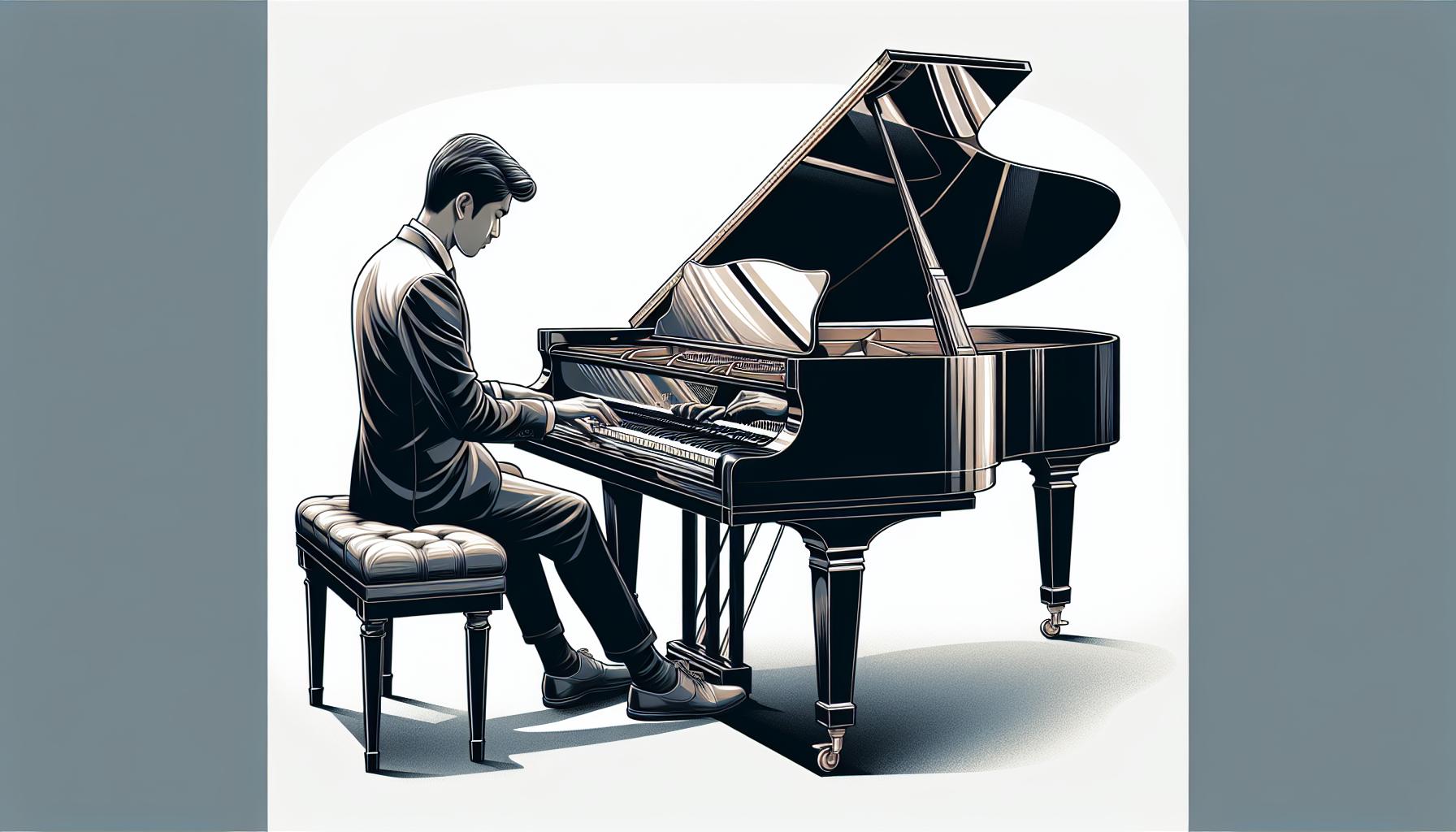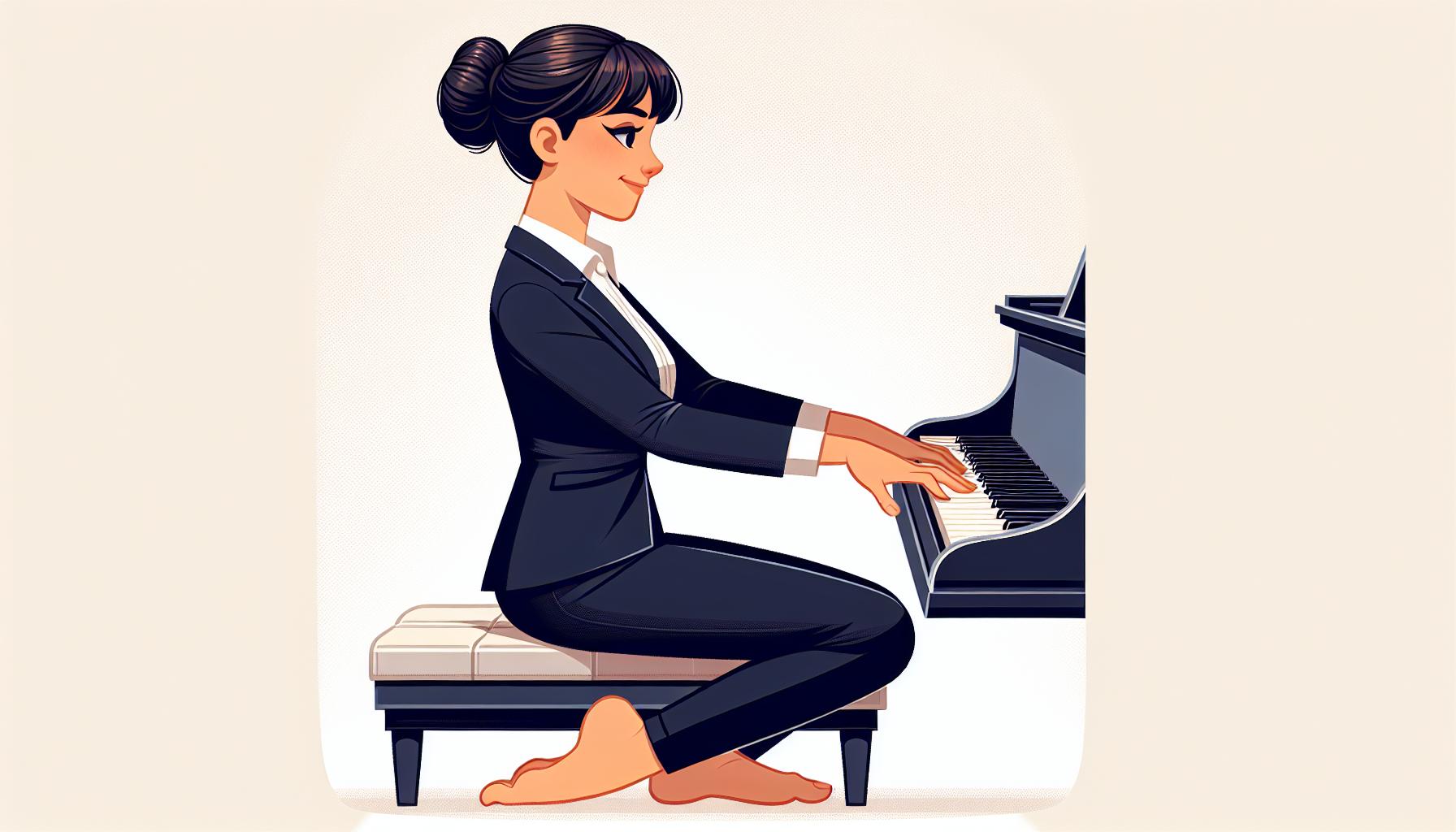Mastering the piano isn't just about hitting the right notes; it's also about how you sit and hold yourself at the keyboard. Many pianists, from beginners to seasoned professionals, often overlook the importance of correct posture. Yet, maintaining the right posture is crucial, especially when playing for long hours. It not only prevents strain and injury but also enhances performance and stamina.
Imagine sitting at the piano, feeling comfortable, and playing your favorite pieces with ease. That's the power of correct posture. It's the foundation that supports every chord and melody, ensuring that playing for extended periods doesn't take a toll on your body. Whether you're practicing for an upcoming performance or simply playing for the love of music, adopting the right posture can make all the difference.
Importance of Correct Posture for Piano Players
Piano playing is an art that demands not just emotional expression and technical skill but also physical endurance. A key component of being able to play for long hours without fatigue is maintaining correct posture. Many pianists, both novice and advanced, often overlook this aspect, not realizing its impact on their playing stamina and overall health.
Correct posture for piano players involves more than just sitting up straight. It encompasses the positioning of the back, shoulders, arms, and even how the feet rest on the floor. Good posture ensures that the body's weight is evenly distributed, minimizing unnecessary tension in any one area. This balance is crucial for preventing injury especially when one engages in long practice sessions.
Moreover, adopting a proper posture enhances musical performance. When a pianist is seated correctly, their arms have the freedom to move more fluidly, allowing for a broader dynamic range and more expressive playing. The correct alignment of the body with the piano also ensures that the force exerted on the keys comes from the proper use of muscles, leading to more precise and consistent playing.
- Prevents Injury: By reducing strain on the back, shoulders, and wrists, good posture reduces the risk of common pianist injuries, such as tendonitis and carpal tunnel syndrome.
- Increases Endurance: Proper alignment and weight distribution allow for more efficient use of muscles, thus reducing fatigue and enabling longer practice sessions.
- Improves Technique: A proper seating position allows for optimal hand position and finger movement, which is essential for playing complex passages and improving overall technique.
- Enhances Expression: With the body comfortably aligned, pianists can focus more on the emotional aspect of their performance, offering a more engaging and expressive rendition of their pieces.
Practical steps to achieve correct posture include adjusting the piano bench to ensure that the forearms are parallel to the floor, keeping the back straight but relaxed, and positioning the feet flat on the floor or on a footrest if they don't reach the ground. It's also important for pianists to be mindful of their posture throughout their practice and make adjustments as necessary.
Incorporating breaks into practice sessions can help maintain good posture. During long hours at the piano, it's easy for the body to gradually shift into less optimal positions. Short breaks allow pianists to stretch and realign their bodies before resuming practice.
Ergonomic Setup of Piano and Bench

The journey toward maintaining correct posture for long piano playing hours begins with the ergonomic setup of the piano and bench. This setup is foundational, as it influences how a musician interacts with the instrument, affecting both performance and physical health over time.
First, let's talk about the piano bench. It's not just a seat; it's an integral part of a pianist's posture. The height of the bench should allow the feet to rest flat on the floor, with knees forming about a 90-degree angle. This position ensures balance and stability, allowing for effective pedal use. A bench that's too high or too low can strain muscles over time, leading to discomfort and potentially impacting performance.
Adjustability is crucial here. Many benches offer height adjustment options, which can cater to the unique physical requirements of each player. Investing in an adjustable bench is a wise choice for those who spend long hours at the piano.
Turning attention to the piano's height, this is generally standardized, especially with grand and most upright pianos. However, digital pianos and keyboards offer more flexibility in this area. If the keyboard is too high, it can lead to elevated shoulder tension. If it's too low, it can cause the wrists to bend unnaturally. Ideally, the keyboard should be positioned so that the forearms are parallel to the floor when the hands are on the keys, promoting neutral wrist alignment.
Distance from the piano also plays a vital role in maintaining an ergonomic setup. Sitting too close can cramp one's style – quite literally – by restricting arm movement and causing the player to hunch over. Conversely, sitting too far can force the reach of keys, straining the back, shoulders, and arms. A good rule of thumb is to sit close enough that the elbows are just slightly in front of the body when the fingers are on the keys, ensuring a comfortable reach for both the keys and the pedals.
To promote an ergonomic setup, consider the following adjustments:
- Bench Height: Adjust until the forearms are parallel to the floor.
- Distance From Piano: Ensure elbows are slightly in front of the body when playing.
- Foot Positioning: Feet should rest flat on the floor with knees at a 90-degree angle.
Proper Seating Position at the Keyboard

Achieving the correct seating position at the piano is pivotal for anyone aiming to play for extended periods without experiencing discomfort. This involves more than just sitting down; it requires careful consideration of one's posture, the bench's placement, and the distance to the keyboard.
Firstly, the bench should be positioned so that the pianist can easily reach all keys of the piano with their arms comfortably extended. This does not mean being so close that one's elbows are tightly by their side, nor so far that they have to stretch to reach the keys. A good rule of thumb is to allow the elbows to slightly protrude in front of the body, ensuring the shoulders remain relaxed.
Moreover, the height of the bench is crucial. Ideally, it should be adjusted so that the forearms are parallel to the floor when the hands are on the keyboard. This position prevents undue strain on the wrists and aids in maintaining a relaxed shoulder posture. Unfortunately, not all benches are adjustable. In such cases, using cushions or adjustable piano stools can provide an adequate solution.
The necessity of a correct seating position cannot be overstressed when it involves playing for long durations. Here are some specifics:
- Distance from Keyboard: The pianist should be close enough to the piano that their fingertips comfortably reach the keys while their arms maintain a gentle curve.
- Bench Height: The height should allow the pianist's forearms to align parallel to the ground, facilitating a natural, strain-free position.
Let's not forget the importance of keeping the feet flat on the ground. This aids in providing stability and balance, which are indispensable for controlling pedal work and supporting the overall posture. For younger players or individuals with shorter stature, a footrest might be necessary to achieve this.
Ergonomics play a significant role in preventing fatigue and discomfort. Thus, adjusting the bench and seating position isn't just about comfort—it's about promoting a healthier playing technique. Regular breaks are also recommended to stretch and alleviate any tension that builds up during long practice sessions.
Understanding and implementing the principles of proper seating can have a transformative effect on a pianist's practice and performance. It not only helps in avoiding potential physical ailments but also enhances the ability to play more expressively. By maintaining an ergonomic setup, pianists can enjoy the beauty of music-making, free from the constraints of discomfort and strain.
Hand and Arm Positioning Techniques

When it comes to mastering the piano, the positioning of one's hands and arms plays a pivotal role in both performance and endurance. Proper alignment not only enhances musical expressiveness but also safeguards against strain and injury. Therefore, understanding and implementing correct hand and arm techniques is essential for those who spend long hours at the piano.
To begin, the wrists should maintain a natural, relaxed curve, avoiding any excessive bending upward or downward. This posture allows for greater agility and precision, enabling pianists to gracefully navigate complex pieces. Moreover, keeping the wrists flexible facilitates dynamic control and aids in the smooth execution of passages.
The fingers should be curved slightly, touching the keys with the tips. This position, often described as holding an imaginary ball, provides a solid foundation for pressing the keys with sufficient force while maintaining sensitivity and articulation. Each finger, from the thumb to the little finger, needs to be engaged effectively to produce a clear, even tone across the keyboard.
Another key aspect of proper technique involves the alignment of the arms. They should be positioned so that the elbows are slightly away from the body, allowing the hands to be centered over the keyboard. This alignment ensures that the force exerted when playing comes from the arms and shoulders, not just the fingers. It's crucial for distributing the workload across the larger muscle groups, thereby reducing fatigue and the risk of repetitive strain injuries.
For those who play for extended durations, maintaining these hand and arm positions can be challenging. Here are a few strategies to help sustain good posture:
- Frequent Breaks: Take short breaks every 20 to 30 minutes to stretch and relax the hands and arms. This regular interval helps prevent cramping and fatigue.
- Exercises: Incorporate specific hand and arm exercises into your practice routine to strengthen muscles and improve flexibility. Exercises focusing on wrist rotation, finger stretching, and forearm strengthening can be particularly beneficial.
- Mindfulness: Stay conscious of your hand and arm positioning while playing. It's easy to revert to bad habits under stress or during difficult passages. Regularly checking and correcting your posture can help embed proper techniques.
Practicing Good Posture for Long Hours

Practicing good posture is crucial for pianists who spend long hours at the keyboard. It's not just about avoiding discomfort; it's also about enhancing musical performance. When seated correctly, pianists have better access to the full range of the keyboard, allowing for more expressive playing.
Finding the Right Seat Height
The first step in maintaining good posture is finding the right seat height. The ideal position allows the forearm and hand to be in line with the keyboard, preventing undue strain on the arm and wrist. A simple guideline is to ensure the elbows are slightly higher than the keys, promoting a natural curve of the fingers.
Positioning the Feet
Another often-overlooked aspect of posture is foot positioning. Feet should be flat on the floor or on a footrest, with the knees at about a 90-degree angle. This position supports the back and allows for proper balance and weight distribution, which is vital for dynamic playing and pedaling.
Maintaining a Neutral Spine
Central to good posture is maintaining a neutral spine. Slouching or leaning too far forward can lead to back pain and reduce lung capacity, affecting breathing and, subsequently, phrasing and expressiveness in playing. Pianists should sit back in their seat, allowing the back to maintain its natural curve without rigidity.
Adjusting Keyboard Distance
The distance between the pianist and the keyboard also plays a critical role in maintaining good posture. Being too close or too far can cause one to overreach or compress their arms, leading to tension. The ideal distance allows the arms to be comfortably extended when playing the keys in the middle octave range.
Breaks and Exercises
Incorporating regular breaks and exercises into practice sessions is essential for sustaining good posture over long hours of play. Short breaks every hour prevent stiffness and fatigue, while simple stretching and strengthening exercises can improve posture and flexibility. Here are a few recommended exercises:
- Shoulder rolls and stretches to relieve upper body tension
- Wrist flexor and extensor stretches
- Finger stretches to maintain flexibility and prevent cramping
| Exercise | Benefit |
|---|---|
| Shoulder rolls | Relieves upper body tension |
| Wrist stretches | Increases flexibility and reduces the risk of strain |
| Finger stretches | Maintains finger flexibility and prevents cramping |
Conclusion
Adopting the right posture isn't just about playing comfortably for hours; it's about ensuring longevity in a pianist's career. By setting up the perfect seat height, positioning feet properly, and keeping that spine neutral, pianists can significantly reduce the risk of discomfort and injury. Remember, the keyboard's distance matters just as much as the breaks and stretches in between sessions. These exercises aren't merely suggestions but essential tools to maintain flexibility and fend off strain. So, let's make these practices a staple in every pianist's routine to not only enhance performance but to cherish the joy of playing for years to come.
Harlan Kilstein began playing piano during covid with no piano background at all. He taught himself how to play learning what to do and what not to do.
Today he's an advanced intermediate player and can help you grow in your skills because he learned all this on his own.








